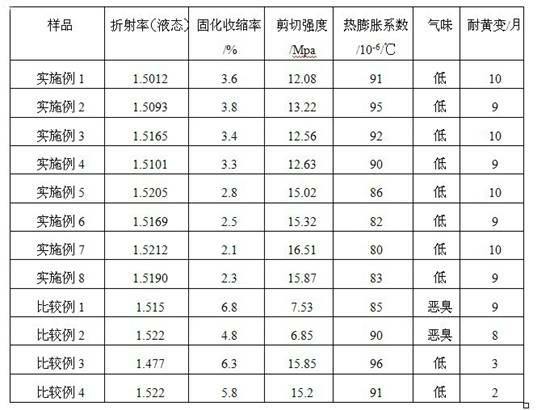Photocuring adhesive used for adhering optic glass lenses and preparation method thereof
An optical glass, light curing technology, applied in the direction of modified epoxy resin adhesives, etc., can solve the problems of poor yellowing resistance, large curing shrinkage, weak adhesion, etc., to achieve good yellowing resistance, The effect of low curing shrinkage and strong adhesion
- Summary
- Abstract
- Description
- Claims
- Application Information
AI Technical Summary
Problems solved by technology
Method used
Image
Examples
Embodiment 1
[0026] Take the following components,
[0027] Main resin: 50g cycloaliphatic epoxy resin UVR6128 (bis((3,4-epoxycyclohexyl)methyl)adipate),
[0028] Auxiliary resin: 40g modified epoxy acrylate resin EBECRYL 3701 (fatty acid modified epoxy acrylate resin),
[0029] Active monomer: 2.5g vinyl ether monomer HBVE (hydroxybutyl vinyl ether), 3g acrylate monomer IBOA (isobornyl acrylate),
[0030] Photoinitiator: 2g photoinitiator Omnicat 550 (iodonium salt), 2g photoinitiator I-184 (1-hydroxy-cyclohexyl phenone),
[0031] Auxiliary agent: 0.5g coupling agent A-174 (γ-methacryloxypropyltrimethoxysilane), stir evenly.
[0032] After conversion, the main resin accounts for 50.0%, the auxiliary resin accounts for 40.0%, the active monomer accounts for 5.5%, the photoinitiator accounts for 4%, and the auxiliary agent accounts for 0.5%.
Embodiment 2
[0034] Take the following components,
[0035] Main resin: 60g cycloaliphatic epoxy resin ERL-4221 (3,4-epoxycyclohexylmethyl, 3,4-epoxycyclohexyl carbonate),
[0036] Auxiliary resin: 25g modified epoxy acrylate resin EBECRYL3639 (polyurethane modified epoxy acrylate resin),
[0037] Active monomer: 5g vinyl ether monomer CHVE (1,4-cyclohexyldimethanol divinyl ether), 5g acrylate monomer HEMA (hydroxyethyl methacrylate),
[0038] Photoinitiator: 3g photoinitiator Omnicat650 (iodonium salt), 1g photoinitiator I-184 (1-hydroxy-cyclohexyl phenone)
[0039] Auxiliary agent: 1.0g coupling agent A-1100 (γ-aminopropyltriethoxysilane), stir evenly.
[0040] After conversion, the main resin accounts for 60.0%, the auxiliary resin accounts for 25.0%, the active monomer accounts for 10.0%, the photoinitiator accounts for 4.0%, and the auxiliary agent accounts for 1.0%.
Embodiment 3
[0042] Take the following components,
[0043] Main resin: 60g cycloaliphatic epoxy resin UVR6105 (3,4-epoxycyclohexylmethyl, 3,4-epoxycyclohexyl carboxylate)
[0044] Auxiliary resin: 20g modified epoxy acrylate resin CNUVE151 (epoxy acrylate resin),
[0045] Active monomer: 10g vinyl ether monomer DVE-3 (triethylene glycol divinyl ether), 5g acrylate monomer HDDA (1,6-hexanediol diacrylate),
[0046] Photoinitiator: 3g photoinitiator I-250 (iodonium salt), 1.5g photoinitiator I-184 (1-hydroxy-cyclohexyl phenone),
[0047] Auxiliary agent: 0.5g coupling agent A-187 (γ-glycidyl etheroxypropyltrimethoxysilane), stir evenly.
[0048] After conversion, the main resin accounts for 60.0%, the auxiliary resin accounts for 20.0%, the active monomer accounts for 15.0%, the photoinitiator accounts for 4.5%, and the auxiliary agent accounts for 0.5%.
PUM
 Login to View More
Login to View More Abstract
Description
Claims
Application Information
 Login to View More
Login to View More - R&D
- Intellectual Property
- Life Sciences
- Materials
- Tech Scout
- Unparalleled Data Quality
- Higher Quality Content
- 60% Fewer Hallucinations
Browse by: Latest US Patents, China's latest patents, Technical Efficacy Thesaurus, Application Domain, Technology Topic, Popular Technical Reports.
© 2025 PatSnap. All rights reserved.Legal|Privacy policy|Modern Slavery Act Transparency Statement|Sitemap|About US| Contact US: help@patsnap.com

